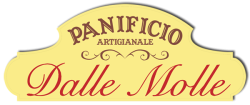
What is sourdough?
What do you know about sourdough?
We asked Giovanni Dalle Molle, an expert baker who has spent his entire life exploring dough fermentation, to tell us about sourdough and its benefits. He explained in detail what sourdough is and how we use it.
Back to the origins: sourdough
Returning to the origins of bread means going back to the key element that allows for natural fermentation: sourdough. Sourdough is considered one of the oldest forms of fermentation: it is known that this method was used in ancient Egyptian civilization as early as 3000 BC and was consumed on a large scale by the entire population.
Produced without the addition of commercial yeast, our bread is born from a natural yeast known as sourdough, levain, or mother dough. It is composed solely of water and flour. When both ingredients are allowed to rest, a culture of beneficial bacteria naturally develops, along with a variety of wild yeasts responsible for fermentation. In this process, the bacteria break down the carbohydrates (sugars) in the flour itself, thereby generating gases such as ethanol and carbon dioxide in the dough. These two components are responsible for creating a well-fermented loaf with characteristic holes that form during baking when the gases come into contact with the heat of our stone oven.
The universe of bacteria is vast, but we must emphasize that the bacteria present in bread are lactic acid bacteria. They are the same bacteria found in other types of ferments such as kimchi, sauerkraut, pickles, beers, and wines.
Characteristics
Since naturally leavened bread requires a longer resting time, fermentation takes much longer compared to other types of bread produced with commercial yeast. It is a slow process that takes approximately 18-24 hours. We need to monitor the sourdough at least three times a day to ensure it has proper hydration, the right percentage of flour, and optimal climatic conditions (humidity and temperature).
The benefits of sourdough bread
It is no coincidence that sourdough bread is considered one of the richest in proteins, minerals, fiber, and has a lower glycemic index. Our digestive system is satisfied with just a couple of slices, and on the other hand, it not only satisfies us but also nourishes us significantly.
Sourdough has the power to enrich our digestive system through a long process of natural fermentation, especially when produced with whole grain flours and cereals, such as einkorn bread, spelt bread, rye bread, seed bread, and Copenhagen bread.
How to store sourdough bread?
Bread is a staple food that has been accompanying our daily lives for ages. For this reason, we seek out breads that make us feel good and help us maintain a balanced diet.
When we purchase a loaf of sourdough bread, we find it very moist and spongy, rich in flavors, and crispy on the outside. Bread made with sourdough can last up to a week in good conditions.
If you have the whole loaf
To maximize the shelf life of the bread, it is recommended not to slice the loaf. This way, less air enters the loaf, and the interior remains moist for a longer period. When the bread is whole, the aromas and flavors continue to develop over the course of several days.
To keep it in good condition, it is advisable to wrap it in a resealable cotton bag or, if you don’t have one, in a cotton cloth that covers the bread well and keeps the air out.
If you have sliced the loaf
Sliced bread tends to lose its outer crispiness more easily and dries out faster. When bread is sliced, it absorbs more air and tends tooxidize more quickly.
To prolong the shelf life of sliced sourdough bread, it is best to store it in a tightly sealed cotton bag or wrap it in a cotton cloth.
If you want to freeze the bread, use a reusable airtight plastic bag. This is the best way to prevent freezer burn (white spots on the bread slices).
